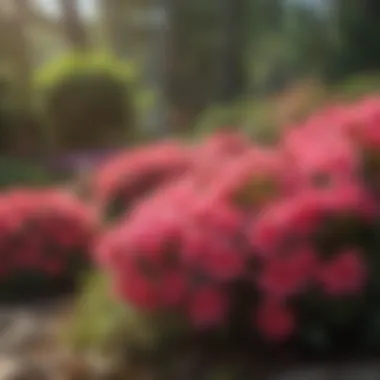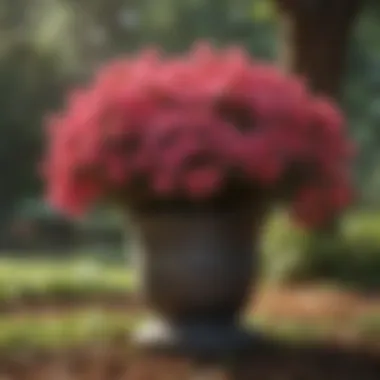Discovering Dwarf Azaleas: A Garden Enthusiast's Guide


Intro
Dwarf azaleas are small, vibrant shrubs that captivate many gardeners. Their compact nature makes them ideal for landscaping projects where space is limited. These plants are known for their stunning blooms that come in a variety of colors. Understanding dwarf azaleas is not just about appreciating their beauty, but also about recognizing their specific needs for successful growth.
Why choose dwarf azaleas? These plants are versatile and can fit into many types of gardens. They can thrive in both sunny and partially shaded areas, making them suitable for different garden designs. Additionally, their relatively low maintenance does not compromise their visual appeal. Gardeners can enjoy a rich floral display without excessive effort.
In this article, we will examine various facets of dwarf azaleas. We will explore their unique characteristics, cultivation practices, and selection tips. By delving into the specifics of these plants, readers can make informed gardening decisions, optimizing the beauty of their outdoor spaces.
Fascinating Facts About Dwarf Azaleas
Unique Characteristics
Dwarf azaleas differ from their larger counterparts in several significant ways. They typically grow to a height of 1 to 3 feet, making them perfect for small gardens. Their foliage is often glossy and dense, which adds an element of texture to the landscape. Moreover, many dwarf azalea species are evergreen, providing year-round interest.
The flowers of dwarf azaleas are another point of fascination. They can range in color from pinks and reds to whites and yellows. The bloom size and structure may also vary, with some species exhibiting funnel-shaped flowers. This diversity allows for creativity in garden design, as combinations can yield a stunning visual display.
Extraordinary Abilities
One notable ability of many dwarf azaleas is their resilience. These plants can withstand various climate conditions, making them relatively easy to cultivate in diverse environments. This adaptability extends to soil types, though they thrive in well-drained, acidic soils.
Furthermore, dwarf azaleas can serve important ecological functions. They offer nectar to pollinators, such as bees and butterflies, contributing to local biodiversity. Through planting these shrubs, gardeners can support wildlife and create a vibrant ecosystem in their yards.
“Dwarf azaleas provide both beauty and ecological benefits, making them a wise choice for any garden.”
Care Requirements for Dwarf Azaleas
Caring for dwarf azaleas is crucial for their longevity and health. Here are the key considerations:
- Watering: These plants prefer consistent moisture but dislike soggy roots. A careful balance is needed.
- Fertilization: Use a balanced, slow-release fertilizer during the growing season to promote healthy blooming.
- Pruning: Regular pruning after flowering helps maintain shape and promotes new growth.
By following these guidelines, gardeners can enhance the growth and beauty of their dwarf azaleas.
Selection Considerations
When choosing dwarf azaleas for your garden, there are several factors to keep in mind:
- Bloom Time: Different species may flower at various times throughout the season. Knowing this can help design a garden with continuous blooms.
- Color Preferences: Consider the overall color scheme of your garden when selecting azalea colors.
- Hardiness Zones: Ensure the selected azaleas are suitable for your local climate zone.
With careful selection, dwarf azaleas can contribute significantly to the beauty and harmony of any garden landscape.
Understanding Dwarf Azaleas
Dwarf azaleas offer unique advantages to gardeners seeking vibrant color in compact forms. They are valued for their aesthetic appeal and adaptability to various landscapes. Understanding their characteristics is vital for selecting the right plants for your garden. With detailed knowledge, you can maximize their potential in your horticultural endeavors.
Definition and Characteristics
Dwarf azaleas are a category of azaleas characterized by their shorter stature. Generally, they grow to a height of 2 to 3 feet and spread wide, making them suitable for smaller gardens or as front-row plants in landscape design. Their foliage is typically evergreen or semi-evergreen, providing year-round interest. Blooms appear in spring, showcasing a range of colors, from vibrant pinks to delicate whites.
The compact size and dense foliage make them ideal for borders, rock gardens, or even as potted specimens. They are hardy plants that can thrive in various conditions, but each variety has specific needs related to soil types, sunlight exposure, and moisture levels. It’s essential to understand these requirements for optimal growth.
Origins and Species Diversity
The origins of dwarf azaleas trace back to their larger relatives, which are native to regions across Asia, Europe, and North America. The most popular species within the dwarf category include Rhododendron obtusum and some hybrids that emerged from complex breeding programs. These hybrids exhibit diverse characteristics, allowing for a wide range of choices in color, leaf shape, and growth habits.


Species diversity plays a crucial role in how dwarf azaleas are utilized in gardens. For instance, the diverse forms allow gardeners to select plants that not only meet aesthetic goals but also grow well in specific climates. This consideration of regional suitability is key for anyone looking to incorporate dwarf azaleas into their botanical repertoire.
"Understanding the characteristics and origins of dwarf azaleas is essential for making informed choices that enhance garden aesthetics while promoting plant health."
In summary, a comprehensive grasp of dwarf azaleas and their distinctive features enriches the selection process. Several varieties offer beautiful blooms, making them an excellent option for diverse gardening strategies. By appreciating their diversity and unique traits, gardeners can strategically plan their landscapes while ensuring vibrant growth and sustainability.
Popular Dwarf Azalea Varieties
Dwarf azaleas are celebrated for their vibrant colors and compact size. Understanding the variety of dwarf azaleas available is essential. Each variety offers unique characteristics and benefits that can enhance any garden. By exploring specific types like Kirin, Hino Crimson, Gumpo Pink, and Dwarf Rhododendron, gardeners can select plants that fit their aesthetic and ecological goals.
Kirin
Kirin dwarf azaleas stand out for their striking red blooms that appear in dense clusters. This variety is known for its hardiness and ability to withstand varying temperature conditions. Kirin plants usually grow to a height of 2 to 3 feet, making them suitable for both borders and as standalone displays. Their glossy green leaves serve as an appealing backdrop to the vivid flowers, creating an impressive visual contrast.
In terms of care, Kirin azaleas require well-drained acidic soil and a moderate amount of sunlight. They thrive in USDA zones 6 to 9, demonstrating resilience in different climates. Choosing this variety can add a dramatic flair to any garden space, pleasing those who appreciate bold colors.
Hino Crimson
Hino Crimson is another popular dwarf azalea. It features rich, deep red flowers that bloom in spring, often enduring through early summer. This variety is compact, typically reaching around 2 feet in height with a similar spread. The consistency in flowering makes Hino Crimson a reliable choice for consistent beauty throughout its blooming season.
This azalea prefers partial shade, thriving in environments that provide protection from intense afternoon sun. It is also noted for its resistance to pests, making it a low-maintenance option for busy gardeners. Selecting Hino Crimson can help create a traditional or contemporary garden look, enhancing the overall appeal.
Gumpo Pink
Gumpo Pink presents soft pink blooms, which lend a delicate touch to garden landscapes. This variety is compact, averaging 1 to 2 feet in height, making it suitable for smaller gardens or as ground cover. Its flowers bloom abundantly, providing a soft contrast against its dark green foliage, which remains attractive even outside the flowering season.
Gumpo Pink azaleas prefer well-drained soil, and they can adapt to various light conditions. While they enjoy partial to filtered sunlight, they are also resilient enough to tolerate full sun when established. Integrating this variety can soften hard landscape edges and supply a gentle color palette.
Dwarf Rhododendron
Dwarf Rhododendron functions as a diverse addition to the dwarf azalea category. Though it shares similarities with traditional azaleas, it tends to exhibit broader foliage and larger flowers. This variety presents an array of color options, including pink, purple, and white, making it highly versatile for various design themes.
Typically reaching heights of 2 to 3 feet, the Dwarf Rhododendron thrives best in well-drained acidic soils and in climates located within USDA zones 4 to 8. The presence of this plant can enrich garden biodiversity, as it attracts pollinators. Thus, they fulfill not only aesthetic roles but ecological ones, enhancing garden ecosystems.
Selecting the right dwarf azalea variety is crucial for creating compatible and stunning garden designs. Each variety has specific needs and characteristics that can impact the overall garden health and attractiveness.
Selecting the Right Dwarf Azalea
Choosing the right dwarf azalea is crucial for achieving a vibrant and flourishing garden. These plants have specific needs and features that must align with your garden's environmental conditions. The benefits of selecting the right species include better growth, healthier plants, and visual appeal. By understanding the needs of dwarf azaleas, gardeners can ensure that their choices will thrive in the specified locations.
Considerations for Climate
When selecting a dwarf azalea, it is essential to consider your local climate. Different species have varying tolerances to temperature extremes and precipitation levels. For instance, varieties such as Hino Crimson may perform better in warmer regions, while others like Kirin thrive in cooler climates. To assess climate suitability, check your USDA hardiness zone. This information can help you determine which azalea varieties are likely to endure in your specific conditions.
Factors affecting climate suitability include:
- Temperature Range: Some dwarf azaleas prefer milder winters and warmer summers.
- Humidity Levels: Higher humidity can benefit azaleas, as they naturally thrive in moist environments.
- Rainfall Patterns: Regular rainfall can supplement watering needs, but too much can cause root rot.
Soil Requirements
Dwarf azaleas also have specific soil needs that affect their growth and health. Ideally, they prefer well-draining acidic soil, enriched with organic material. Poorly drained or alkaline soils can lead to poor growth and susceptibility to diseases.
To improve soil conditions, consider:
- Soil pH: Aim for a pH between 5.0 and 6.0. Soil testing kits can help determine current levels.
- Organic Matter: Incorporate amendments like compost or peat moss to enhance soil quality.
- Drainage: Ensure adequate drainage by avoiding heavy clay soils or adding grit to improve texture.


Implementing these practices will create a supportive environment for your azaleas, enabling them to flourish.
Sunlight and Location
The placement of dwarf azaleas in your garden affects their overall health and flowering potential. While most varieties prefer partial shade to full sun, the exact requirements can vary by species. Observing the sunlight patterns in your garden will assist in making the right decision.
Key considerations for sunlight and location include:
- Sun Exposure: Monitor how much sun different areas of your garden receive throughout the day.
- Wind Protection: Choosing a location that is shielded from harsh winds can prevent damage to delicate blooms.
- Space for Growth: Ensure that azaleas have adequate space to grow without competing with nearby plants.
The success of your dwarf azalea lies not only in choosing the right variety but also in providing suitable conditions for growth. By considering climate, soil, and location, your garden can become a thriving habitat for these beautiful plants.
Planting Dwarf Azaleas
Planting dwarf azaleas is a critical part of ensuring their successful growth and visual appeal in any garden. These compact shrubs not only add vibrant colors but also require careful attention to their planting conditions. The right approach can help these plants thrive, allowing gardeners to enjoy their beauty for years. Selecting the optimal time for planting, understanding soil requirements, and recognizing the importance of location all contribute to the overall health of dwarf azaleas.
Best Practices for Planting
When planting dwarf azaleas, several best practices should be observed:
- Choosing the Right Time: The ideal planting period for dwarf azaleas is during early spring or fall. Planting during these times allows roots to establish effectively before the extreme temperatures of summer or winter.
- Preparing the Soil: Azaleas prefer well-drained, slightly acidic soils. Mix in organic matter, such as compost, to improve drainage and soil structure. The pH level should ideally be between 5.0 and 6.0, which can be checked with a soil test.
- Digging Properly: Prepare the planting hole by digging a width that is twice the container size of the azalea and deep enough to accommodate the root ball. This allows roots to spread easily in their new environment.
- Watering: Ensure that the plant is well watered before placing it in the hole. Once planted, watering should continue regularly to maintain soil moisture without creating waterlogged conditions.
Following these practices helps ensure that your dwarf azaleas have the best start in their new home.
Spacing Requirements
Proper spacing is crucial to the success of dwarf azaleas in any garden. These plants can grow wide, and adequate space allows for air circulation and light penetration. When determining how far apart to plant dwarf azaleas, consider the following:
- Average Width: Most dwarf azaleas range from 2 to 3 feet in width, depending on the variety. It’s smart to check specific spacing recommendations provided for each type.
- Planting Distance: Ideally, space dwarf azaleas about 2 to 3 feet apart. This provides enough room for their growth while also allowing for easy maintenance and observation of any pests or diseases.
- Design Considerations: If creating a border, consider aesthetic factors and aim for an alternating pattern that prevents overcrowding.
Adhering to these spacing requirements can lead to a more vibrant, healthy garden that showcases the unique beauty of dwarf azaleas.
Caring for Dwarf Azaleas
Caring for dwarf azaleas is crucial for maintaining their aesthetic appeal and health. These plants require specific attention to thrive in various climates. Dwarf azaleas not only beautify a garden, but they also contribute positively to the local ecosystem. Understanding their care allows gardeners to ensure vibrant blooms and optimal growth.
Watering Routine
Watering is a fundamental part of caring for dwarf azaleas. These plants prefer consistently moist soil but can suffer from root rot if overwatered. Establishing a regular watering schedule is essential. Here are some key points about watering dwarf azaleas:
- Frequency: Water them thoroughly once a week during dry periods. In cooler months, reduce the frequency.
- Method: Use a soaker hose or drip irrigation to ensure even moisture distribution.
- Soil Check: Always check the top inch of soil; if it feels dry, it’s time to water.
Remember, dwarf azaleas benefit from consistent moisture but dislike waterlogged conditions.
Fertilization Guidelines
Fertilizing dwarf azaleas appropriately contributes to their growth and flowering. The right nutrients help strengthen the plants, making them more resilient to pests and diseases. Here are some strategies for effective fertilization:
- Type of Fertilizer: Use a balanced, slow-release fertilizer specially formulated for acid-loving plants. Products that include ammonium sulfate can be beneficial.
- Application Time: Fertilize in early spring before new growth appears. A second application in late summer can promote healthy blooms.
- Amount: Follow package instructions closely to avoid over-fertilization. Generally, applying about one pound of fertilizer per 100 square feet is adequate.
Pruning Techniques
Pruning is a significant practice when caring for dwarf azaleas. Proper pruning enhances air circulation and sunlight penetration, which boosts overall plant health. Here are some techniques to bear in mind:


- Timing: The best time to prune is immediately after flowering. This timing helps maintain the shape and size without sacrificing blooms.
- Method: Remove dead or diseased branches first, then shape the plant by cutting back long, leggy branches. This promotes a fuller appearance.
- Tools: Use clean, sharp pruning shears to make clean cuts. Avoid tearing the branches as it can lead to infections.
In summary, caring for dwarf azaleas involves a clear understanding of their watering, fertilization, and pruning needs. By following these guidelines, gardeners can maximize the potential of these attractive and versatile plants.
Common Issues and Troubleshooting
Common issues are often the hidden adversaries that can undermine the beauty and health of dwarf azaleas. Addressing these challenges is crucial for any gardener aiming for a flourishing landscape. By recognizing potential problems early on, gardeners can implement effective solutions to maintain the vibrancy and vitality of their plants. This section dives into two primary areas concerning dwarf azaleas: pests and diseases, as well as nutrient deficiencies.
Pests and Diseases
Dwarf azaleas can attract a variety of pests, which pose a threat to their health and growth. Common pests include aphids, spider mites, and lace bugs. Each of these insects has unique characteristics and can lead to various symptoms in plants. For instance, aphids suck sap from the leaves, leading to yellowing and curled foliage. Spider mites, on the other hand, can cause fine webbing on the undersides of leaves and result in stippling.
Preventive measures, such as maintaining plant health, can significantly reduce the likelihood of pest infestations. Regular inspections are a good practice. Should pests be identified, choices for treatment range from natural remedies to chemical insecticides. The selection depends on how severe the infestation is, and the gardener's preference for organic versus synthetic treatments. Additionally, it's essential to ensure good air circulation around the plants, as poorly ventilated areas are prone to pests.
Diseases also affect dwarf azaleas. Fungal infections, such as powdery mildew and root rot, can severely impact plant health. Powdery mildew often manifests as white powder on leaves and can be treated with fungicides or home remedies like a baking soda solution. Meanwhile, root rot is due to overwatering or poor drainage, leading to the decay of roots. To counter this, improving soil drainage or reducing watering frequency is advisable.
Nutrient Deficiencies
Nutrient deficiencies are another aspect that can compromise the growth of dwarf azaleas. These plants require specific nutrients to thrive, including nitrogen, phosphorus, and potassium. A deficiency in any of these can result in poor growth and unappealing foliage.
Signs of nutrient deficiency vary. For instance, a lack of nitrogen often leads to yellowing leaves, especially in older foliage. A deficiency in phosphorus may cause stunted growth and limited flowering. Potassium deficiency is less common but can lead to browning leaf edges. To successfully address these issues, soil testing is recommended. This step allows gardeners to determine which nutrients are lacking and to what extent.
Fertilization plays a vital role here. Choosing a balanced fertilizer designed for azaleas can aid in improving nutrient availability. Application should be based on the specific needs of the plants and aligned with their growing season. The timing and manner of fertilization can significantly impact overall plant health.
Regular monitoring of azaleas for pests and diseases, along with proper nutrient management, can help maintain their health and beauty.
Ecological Impact of Dwarf Azaleas
Dwarf azaleas hold significance not just for their aesthetic appeal, but also for their role in ecosystems. When planted, they can significantly contribute to local biodiversity and support soil health. These benefits should be considered when choosing plants for your garden.
Biodiversity Support
Dwarf azaleas serve as essential habitats and food sources for various wildlife. Their blossoms attract pollinators such as bees and butterflies. In fact, a well-planted dwarf azalea can draw a variety of other insects, which are critical to maintaining a balanced ecosystem.
Furthermore, these plants can provide shelter for small birds and beneficial insects. This presence promotes a more vibrant local wildlife population. More plants mean more interactions between species, leading to a healthier environment. When you choose dwarf azaleas, you are not only beautifying your garden but also enhancing the biodiversity of your area.
"A garden that encourages wildlife strengthens the ecological fabric of our environment."
Contributions to Soil Health
The presence of dwarf azaleas can enhance soil health in several ways. First, their roots help to hold soil in place, preventing erosion. This stabilization is especially crucial on slopes or areas prone to runoff. Additionally, dwarf azaleas have specific relationships with soil microorganisms, which can improve nutrient availability.
When these plants decompose, they contribute organic matter back into the soil, enriching it. This process helps maintain soil structure and improves moisture retention. Healthy soil is fundamental to the growth of plants and the overall well-being of garden ecosystems. Selecting dwarf azaleas can enrich the soil, promoting a more robust growing environment for various plants.
The End
Dwarf azaleas are not just ornamental plants; they offer a range of benefits that enhance overall garden health and aesthetics. Understanding their significance allows gardeners to appreciate their value in diverse ecological systems. Selecting the right varieties, planting them appropriately, and maintaining their health paves the way for a vibrant landscape. Moreover, their contribution to biodiversity cannot be overstated, as they attract various pollinators and other wildlife.
Summarizing Key Points
- Diversity of Varieties: Many dwarf azalea species and hybrids exist, each with unique characteristics suitable for different gardening contexts.
- Climate and Soil Considerations: Successful growth depends on proper climate adaptation and soil conditions tailored to specific dwarf azalea needs.
- Planting and Care Practices: Implementing best practices in planting and ongoing care ensures longevity and robust health of these plants.
- Potential Issues: Awareness of common pests, diseases, and nutrient deficiencies helps in timely troubleshooting.
- Ecological Role: Dwarf azaleas support local biodiversity and contribute positively to the soil ecosystem.
These elements underline the importance of integrating dwarf azaleas into garden designs. They not only add vibrant colors but also enhance the ecological balance.
Encouraging Sustainable Gardening Practices
As gardeners, we share responsibility for nurturing our environment. Encouraging sustainable practices when working with dwarf azaleas can significantly impact local ecosystems. Here are some considerations:
- Native Species Utilization: Opt for native dwarf azaleas when possible, as they are better adapted to local conditions and provide vital support to local wildlife.
- Minimal Chemical Use: Reduce dependency on chemical fertilizers and pesticides. Instead, explore organic alternatives that maintain soil health and promote biologic diversity in your garden.
- Water Conservation: Implement efficient watering systems, such as drip irrigation, to conserve water and protect plant health during dryer seasons.
- Pollinator-Friendly Habitats: Create gardens that are inviting to pollinators by planting a variety of species that bloom at different times.
- Soil Health: Regularly amend soil with organic material to ensure it retains nutrients and sustains healthy plant growth.
By adopting these practices, gardeners can cultivate a thriving environment that honors both aesthetic appeal and ecological importance.







